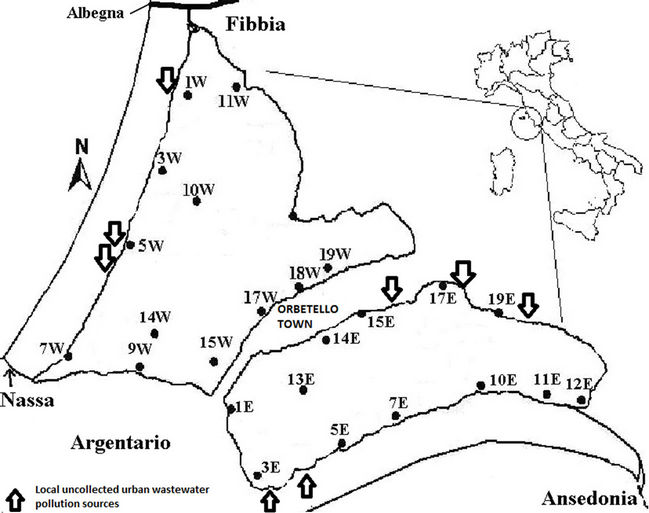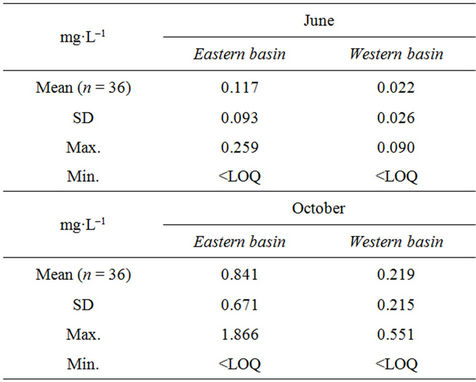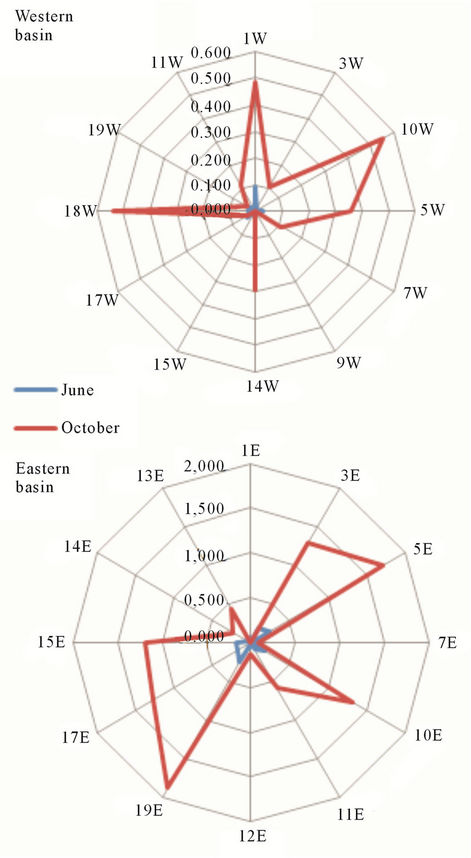Journal of Environmental Protection
Vol. 3 No. 9 (2012) , Article ID: 22649 , 6 pages DOI:10.4236/jep.2012.39116
Water Pollution by Surfactants: Fluctuations Due to Tourism Exploitation in a Lagoon Ecosystem
![]()
1Research Centre in Lagoon Ecology, Fishery and Aquaculture (Ecolab), University of Siena, Orbetello, Italy; 2Department of Environmental Science, University of Siena, Siena, Italy.
Email: renzi2@unisi.it
Received June 7th, 2012; revised July 12th, 2012; accepted August 11th, 2012
Keywords: MBAS; Thyrrenian Sea; Orbetello Lagoon; Pollution; Turism Exploitation
ABSTRACT
This paper describes recent levels of surfactants measured in a coastal lagoon ecosystem highly stressed by human activites: the Orbetello lagoon (Southern Tuscany, Italy, Ramsar Site IT008). Significance of difference among concentrations measured before and after summertime are explored in order to evaluate effects related to tourism exploitation. Among surfactants, methylene blue active anionic substances (MBAS) are selected as tracers for untreated discharges originated by domestic and urban activities. Water samplings were performed in 2011 following a randomly replicated nested logic model (n = 144). MBAS mean level of 0.070 mg·L–1 (<0.001 - 0.259 mg·L–1) and 0.530 mg·L–1 (
1. Introduction
In Italy, commercial activities linked to the tourism which are settled along the coastline evidence a notably enhance during warmer seasons. Increases of seasonal inhabitants in summer produce as principal environmenttal effect an associated growth of human pressures on coasts.
In the case of the Orbetello Municipality, the literature reportes over than a triplication of the human presence from June to October.
The great economic development of the Orbetello Municipality occurred between the First and the Second World Wars due to the building of the S. Stefano’s railway station which enhanced the extra moenia architecttural development of Orbetello. Transoceanic flights improving exchanges between the city and North America let tourism and local inhabitants grew from 3.965 (1921) to 4.781 (1931) till to 6.444 inhabitants recorded in 1951. From this period to nowadays tourism progressively increased till to reach over than 600.000 inhabitants distributed within only three months [1,2].
Till 2008, this occurrence severly affected the water quality of the Orbetello lagoon and, consequently, fishery productivity due to increased nutrient charges associated to mulfunctions of municipal wastewater treatment plants [1]. This ecosystem is both a Ramsar (IT008) and Natura 2000 site and water quality represents a key point for human exploitation and protected species conservation. For this reason, after a severe dystrophic crisis occurred in 1992, the Italian Government planed actions for mitigating human impact, included the Orbetello lagoon in the list of “High Environmental Risk Area” and instituted the OLERA: Orbetello Lagoon Environmental Reclamation Authority. Among actions adopted by OLERA to reduce human pressures, millions of Euros have been spent to increase water exchanges between lagoon and adjacent marine coastal areas and to reduce nutrient loads discharged by human activities into lagoon water. A complete restructuration of the municipal wastewater treatment plants was performed and, beginning from 2008, treated effluents are collected and discharged into the sea rather than inside the lagoon [2].
In spite of that, the complete collectation of little domestic agglomerates and older urban areas, is not jet completed and the occurrence of untreated effluents represent a criticism which could determine significant levels of chemicals of ecotoxicological concern in lagoon water.
In Orbetello lagoon, the occurrence of pollution by surfractants was documented in 2002 before the OLERA apported structural changes in wastewater management strategies [3].
The aim of this paper is to evaluate, on a statistical basis, recent surfactants levels in Orbetello lagoon water and to determine possible effects induced by turism expolitation in summertime.
Among surfactants, methylene blue active anionic substances (MBAS) are selected in this study, for the following reasons: 1) levels of these compounds in coastal water are documented by the literature; 2) MBAS method of quantification is relatively simple to perform and cheap; 3) MBAS are good tracers for effluents from domestic or urban activities frequently used in environmental monitorings; 4) adverse effects produced by this substances on biota are documented by the literature [4].
2. Matherials and Methods
2.1. Study Area Features
The Orbetello coastal lagoon (Central Tyrrhenian sea) was selected as study area due to the general scientific knowledge acquired from previous researches on geomorphologic, physico-chemical, biological aspects, and human-due pressures distribution [5-8].
It is one of the largest brackish lagoons of the Western Mediterranean characterized by a poly-hyperhaline feature. The total surface area is about 27 km2, with an average depth of 1.2 m. The lagoon comprises two communicating ponds (named Western and Eastern) separated by the Orbetello urban settlement. Lagoon basins are separated from the open sea by two sandbars named “Giannella” (from Albegna river to Nassa canal) and “Feniglia” (from Argentario Mountain to Ansedonia canal). During the greatest part of the year (from April to October) lagoon-sea water exchanges are human managed and directed by artificial pumps from two water inlets located in the Western pond towards one water outflow sited in the Eastern ones. This produce a geographically-oriented water flux from the Western toward the Eastern basin.
A collection of literature references more detailed describing environmental principal features of the Orbetello lagoon and human-due impacts affecting the study area is reported by Giovani et al. [9].
2.2. Chemical Caracteristics of Selected Surfractants
Methylene blue active anionic surfactants (MBAS) represent a family of chemicals originated by human activities linked to domestic purposes. Ecotoxicological tests performed on Vibrio fischeri evidence an increasing toxicity of MBAS with concentrations in water [10]. Even if the linear alkyl sulphonate (LAS) component of MBAS represents the much ecotoxicological active fraction, in Italy MBAS are actually regularly included in water monitoring programmes (Decree of Low n. 152/06).
2.3. Experimental Design, Samplings & Laboratory Analyses
The experimental design was focused to evaluate, on a statistical basis, the significance of selected factors (basin, month) in segregating samples related to measured MBAS levels. Samplings were sized to reduce Type I and Type II errors according to logic models [11-13] developed considering specific statistical targets a priori defined. Water samplings were performed in 2011 according to a nested-replicated logic model based on a statistical strategy supported by the cited literature. The logic model developed was based on three factors: basin (two levels, fixed: Eastern versus Western), month (two levels, fixed and orthogonal: from 1 to 3), and replicates (three levels, random).
Sampling stations (Figure 1) were geo-referenced using a portable geographical positioning system (Garmin, mod. e-Trex legend) and equally distributed (12 sampling stations per basin) within the Orbetello lagoon to evaluate significant segregations concerning the factor “basin”. Each station was sampled in three different dates randomly defined within the same month replicating samplings both in June and October to evaluate significant differences related to the factor “month”. The significance of crossed variance “basin” × “month” was, also, evaluated.
Complexively 144 observations were performed (12 sampling stations × 2 basins × 2 months × 3 dates random replicates).
In Figure 1, localization of local hot-spot of pollution due to uncollected wastewater treatment effluents are evidenced using black arrows.
MBAS levels measured in June and October are considered representative of the effect induced by the tourism on water pollution.
At each sampling station, sub-superficial water samples (–50 cm) were collected using pre-cleaned darkned glass bottles according to methodological procedure guidelines [14]. Codified bottles were kept on ice at about 4˚C and transferred to the laboratory for analyses.
MBAS quantifications were performed immediately to

Figure 1. Goreferenced localization of sampling stations.
avoid samples deterioration following a chloroformbased extraction method and developing quantifications by a double-ray spectrophotometer (Jenway, mod. 6505 UV/Vis) [14]. Instrument response was calibrated using an opportune concentration constructed chloroform calibration curve.
Differences of evaporation rates could affect observed MBAS distributions and levels within the Orbetello lagoon, for this reason salinity levels measured by previous researches [6] in superficial water collected closed to sampling stations reported in this study, are considered in statistical analysis as possibile factors able to affect MBAS distribution.
2.4. Quality Assurance & Quality Control
Laboratories complies with the standard ISO 9001:2000 and ISO 14001 for ecotoxicological analysis of sediments and organisms (reg. no. IT33804).
Chemicals and reagents were analytical grade (Sigma Aldrich®) and glassware was carefully washed to avoid sample cross-over contamination. Recoveries and reproducibility were checked by analysing procedural blanks and performing laboratory inter-calibrations on similar matrix. A standard reference solution was analysed in statistical replicates (n = 5) at each sampling set of analyses to calculate averages percentages of recoveries which were within 91% - 97% (standard deviation 0.4% - 1.3%). Measured analytical concentrations were not recovery corrected. Limit of detection was defined as the average blank (n = 5) plus three standard deviation whereas the limit of quantification (LOQ) was calculated for the adopted procedures by progressive serial dilution of a standard solution and was 0.001 mg·L–1.
Inter-calibrations exercises were performed on a similar matrix with a SINAL certified laboratory (Nautilus, Vibo Valentia, Italy) evidencing results always included within 20% of variation.
2.5. Statistical Analyses
Statistics were performed using the GraphPad Prism (GraphPad Software, San Diego California USA, www. graphpad.com) software package. Univariate routines were calculated on row data in order to define mean levels of MBAS and associated fluctuations for each factor of interest. Furthermore, results were statistically analysed in order to evaluate significant segregations among levels measured in sampling stations due to considered factors of interest (basin and month). Significant segregations were tested by the application of the two-ways ANOVA (ANalysis Of VAriance) routine. Significance of MBAS segregations observed was tested, also, according levels of salinity measured by the literature [6]. Multivariate ANOSIM (ANalysis Of SIMilarity) oneway test, imposing salinity levels as factor in MBAS segregation, was performed using the PRIMER-E Ltd v. 6.0 Software (Plymouth Routines in Multivariate Ecological Research).
3. Results
Results obtained by the univariate routine calculated on MBAS levels are summarized in Table 1. Means, range of fluctuation (minimum and maximum values) and standard deviations (SD) are reported grouping data separately for both factors of interest (month and basin) with an n = 36 associated to each statistic.
In Table 2 results obtained by the two-ways ANOVA statistics performed on the whole dataset (n = 144) are reported with the associated level of significance.
In Figure 2 MBAS levels measured in each sampling stations for both Western and Eastern basins are reported as mean values (n = 3) measured in June and October.
MBAS mean levels measured in Western basin of the Orbetello lagoon are notably lower than Eastern ones both in June and October.
Furthermore, results evidence significant differences of MBAS levels due to considered factors (basin and month). Also the presence of numerous uncollected domestic sources of pollution localized all around the Orbetello urban settlement (18W, 17E, 15E, 14E) and inside the sandbars Giannella (1W, 3W, 5W, 7W) and Feniglia (3E, 5E, 10E, 11E) is recorded.
ANOSIM one-way test, performed to evaluate significance related to the factor “salinity levels”, evidenced the absence of a clear relationship among water salinity and MBAS measured values.

Table 1. Univariate statistics on collected data.

Table 2. Two-ways ANOVA results.

Figure 2. MBAS levels (mg·L–1) in each sampling station.
4. Discussion
Measured levels of MBAS in lagoon water are higher than values reported for coastal water by the Local Regional Agency of Environment Protection of Tuscany (www.arpat.toscana.it/). MBAS concentrations observed in this study are frequently similar to values recorded by the literature for primary effluents (1.20 - 9.34 mg·L–1 [10]).
A lot of hot-spot pollution sources originated by domestic human activities are evidenced all around the urban settlement but, also, closed to uncollected houses settled inside the Giannella (IT21, WWF Nature Sanctuary coinciding with National and Provincial Reserve “Laguna di Orbetello di Ponente”) and Feniglia (IT02, National Natural Reserve “Duna di Feniglia”) sandbars.
Summer tourism induces levels of MBAS in lagoon water to increase of almost an order of magnitude in both basins. Recorded higher concentration in Eastern basin than in Western ones reflect the general trend previously observed in this ecosystem for nutrients [6] as a result of the water circulation management performed from May to October by artificial pumps. In fact fluxes from the Western toward the Eastern basin induce water concentration of chemicals in the latter ones. A statistical relationships between MBAS levels and water salinity (the descriptor selected to trace water evaporation phenomena) is not observed. This is, probably, caused by the contextual effect on MBAS levels of both freshwater discharges inputs and evaporation on MBAS levels. From June to October 2011 (the whole period considered in this study), only seven rainy days were recorded allowing to exclude the occurrence of significant dilution phenomena due to atmospheric precipitations.
Even if LAS represents the principal component of MBAS responsible of toxicological effects, some evidences are reported by the literature concerning toxicity induced by MBAS exposure of aquatic species [10]. MBAS observed fluctuations could represent a synergical factor able to interfere with the documented seasonal and annual fluctuations of phanerogams distribution inside the Orbetello lagoon [9]. Furthermore, wind-driven areosols and foams containing MBAS which could be formed from hot-spot sources could affect riparian vegetation all around the lagoon basin [4] producing undesiderable effects on local protected species (i.e. Pistacia lentiscus, Phillyrea angustifolia, Salicornietum radicantis, Sarcocornia perennis, Arthrocnemum macrostachium, Arthrocnemetum macrostachyum, Sphenopus divaricatus) whom presence and distribution around the Orbetello lagoon is documented by technical reports [15].
For these reasons, further studies aimed to evaluate the percentage of LAS contributing to the MBAS levels measured are needed to clarify toxicological aspects related to species distributions inside the lagoon basin.
An aspect of particular concern is linked to chemical factors able to negatively affect phanerogams distribution. In spite of that, results evidence a clear relationsgip between levels measured in correspondence of hot-spot sources of pollution and the summer season due to the tourism exploitation of little houses agglomerates and urban areas not jet collected to the wastewater treatment plant. Studies finalized to correlate observed MBAS levels with aquatic phanerogams distributions within the lagoon will be developed.
Further management actions should be focalized on reducing untreated sources of MBAS in this ecosystem and should include a complete revision of uncontrolled effluents.
5. Acknowledgements
Authors are grateful to Carmine De Francesco for organization and performing of sampling activities. A special thank to the Orbetello Pesca Lagunare fishing Society for logistical support. Furthermore, we are grateful to the Nautilus Society (Loc. Trainiti, Vibo Valentia, Italy) for their analytical support in validating acquired data performing inter-calibration exercises.
REFERENCES
- M. Renzi, G. Perra, C. Guerranti, E. Franchi and S. Focardi, “Abatement Efficiency of Municipal Wastewater Treatment Plants Using Different Technologies (Orbetello Lagoon, Italy),” International Journal of Enviornment and Health, Vol. 3, No. 1, 2009, pp. 58-70. doi:10.1504/IJENVH.2009.022905
- A. Ludovico, “La Laguna di Orbetello: Studi, Ricerche, Criteri e Modalità di Intervento in Quattro Anni di Gestione Commissariale 2003-2006,” Graffietti Stampati, Montefiascone (VT), 2006.
- I. Corsi and S. Focardi, “Nonylphenols in a Lagoon Environment: p-Nonylphenol and Nonylphenol Ethoxylates in Fish Tissue,” Bulletin of Environmental Contamination and Toxicology, Vol. 68, No. 6, 2002, pp. 908-914. doi:10.1007/s00128-002-0040-7
- F. Bussotti, P. Grossoni and F. Pantani, “The Role of Marine Salt and Surfactants in the Decline of Tyrrhenian Coastal Vegetation in Italy,” Annals of Forest Science, Vol. 52, No. 3, 1995, pp. 251-261. doi:10.1051/forest:19950306
- M. Bucci, E. Ghiara, V. Gorelli, R. Gragnani, G. Izzo, L. Morgana, L. Naviglio and R. Uccelli, “Ecological Conditions in the Orbetello Lagoon and Suggested Actions for Its Restoration,” Science of the Total Environment, Vol. 126, Suppl. 2, 1992, pp. 1179-1188.
- A. Specchiulli, S. Focardi, M. Renzi, T. Scirocco, L. Cilenti, P. Breber and S. Bastianoni, “Environmental Heterogeneity Patterns and Assessment of Trophic Levels in Two Mediterranean Lagoons: Orbetello and Varano, Italy,” Science of the Total Environment, Vol. 402, No. 2-3, 2008, pp. 285-298. doi:10.1016/j.scitotenv.2008.04.052
- A. Specchiulli, M. Renzi, T. Scirocco, L. Cilenti, M. Florio, P. Breber, S. Focardi and S. Bastianoni, “Comparative Study Based on Sediment Characteristics and Macrobenthic Communities in Two Italian Lagoons,” Environ- mental Monitoring and Assessment, Vol. 160, No. 1, 2010, pp. 237-256. doi:10.1007/s10661-008-0691-x
- C. Lardicci, S. Como, S. Corti and F. Rossi, “Recovery of the Macrozoobenthic Community after Severe Dystrophic Crises in a Mediterranean Coastal Lagoon (Orbetello, Italy),” Marine Pollution Bulletin, Vol. 42, No. 3, 2001, pp. 202-214. doi:10.1016/S0025-326X(00)00144-2
- A. Giovani, E. Mari, A. Specchiulli, L. Cilenti, T. Scirocco, P. Breber, M. Renzi, S. E. Focardi and M. Lenzi, “Factors Affecting Changes in Phanerogam Distribution Patterns of Orbetello Lagoon, Italy,” Transitional Water Bulletin, Vol. 4, No. 1, 2010, pp. 35-52. doi:10.1285/i1825229Xv4n1p35
- J. C. Bradley, “Toxicity of Anionic Surfactants in a Primary Effluent: Identification, Characterization and Removal,” Master’s Thesis, The University of British Columbia, Vancouver, 2004. http://hdl.handle.net/2429/15492
- A. J. Underwood, “Beyond BACI: The Detection of Environmental Impact on Populations in the Real, but Variable, World,” Journal of Experimental Marine Biology and Ecology, Vol. 161, No. 2, 1992, pp. 145-178. doi:10.1016/0022-0981(92)90094-Q
- A. J. Underwood, “The Mechanics of Spatially Replicated Sampling Programs to Detect Environmental Impacts in a Variable World,” Australian Journal of Ecology, Vol. 18, No. 2, 1993, pp. 99-116. doi:10.1111/j.1442-9993.1993.tb00437.x
- L. B. Cecchi, “Experimental Design and Hypothesis Testing in Ecology,” Biologia Marina Mediterranea, Vol. 11, No. 1, 2004, pp. 407-455.
- “ASTM D2330-02 Standard Test Method for Methylene Blue Active Substances,” 2011. http://www.astm.org/Standards/D2330.htm
- A. Cocchi, C. Scoccianti and P. Pacini, “L’ambiente ed il Territorio di Orbetello,” 2005. http://www.comune.orbetello.gr.it/public/pdf/atti/urbanistica/npsorb/allegati/all6/Ambiente_territorio_Orb.pdf

